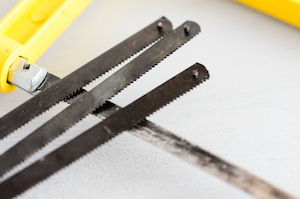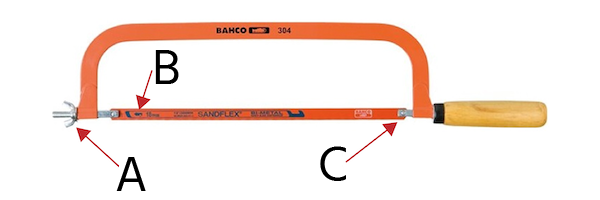How To Replace a Hacksaw Blade

Figure 1: Hacksaw blades.
Hacksaws are ideal for cutting through metal and plastic. The hacksaw’s blade will need replacement when it breaks, wears, or when a specific application needs a particular blade. This article takes a closer look at how to replace a hacksaw blade on pistol and straight handle hacksaws. Read our hacksaw tool article to learn more about how to use a hacksaw.
View our online selection of hacksaws!
When to replace a hacksaw blade
Broken blade
The typical reasons for a hacksaw blade breaking are:
- Improper blade installation.
- Too much pressure on the blade during use, specifically during the backstroke.
- Wrong blade for the material being cut.
- Too much heat during cutting. Mitigate heat by applying oil to the blade before cutting.
Worn blade
Whether a hacksaw is rarely used or not, its blade will wear out. Replace the blade every six months to a year, depending on the frequency of use. To check the hacksaw blade's coarseness, run a finger backwards along the blade's teeth (they face forward). If the coarseness is the same as when running a finger forwards along the blade, it’s time to change it.
Application specific blade
18 and 24 TPI hacksaw blades are suitable for most general workshop applications. However, a general use hacksaw blade needs replacement in specific cases. For example, cutting thin walled tubing requires a very fine 32 TPI blade. For more examples and comprehensive on when to replace a blade for a specific application, read our hacksaw blade selection article.
Changing a hacksaw blade
It is important to wear gloves and safety glasses when changing a hacksaw blade in case the blade breaks. Follow these steps to replace the blade:
- Loosen the wingnut (Figure 2 labeled A) or tensioning knob on the hacksaw’s frame by turning it counterclockwise. This step removes tension on the blade so it can be removed.
- Remove the blade by pulling its ends off the pins they attach to (Figure 2 labeled C).
- Position the new blade in the same orientation as the old blade. Ensure that the blade’s teeth face forward, as seen in Figure 2. There may be an arrow on the blade that shows which way to install it.
- Once the blade’s ends are on the supporting pins, turn the wingnut or tensioning knob clockwise. The blade needs to be very tight and not wobble. The general advice is to tighten the wingnut until it feels tight, then turn it three more times.

Figure 2: Hacksaw blade: wingnut (A), arrow showing the direction the blade's teeth should face (B), and pins on the frame (C)
Changing a junior hacksaw blade
Junior hacksaws are simpler and smaller versions of regular hacksaws. These tools are suitable for quick and easy cutting jobs. Some junior hacksaws have tensioning knobs or wingnuts, but others do not. For handsaws without wingnuts, follow these instructions to replace the blade:
- Use one or both hands to compress the frame. In other words, pull both ends of the frame towards each other to remove tension on the blade.
- Remove the blade from the supporting pins.
- Compress the frame once again to install a new blade in the correct orientation.

Figure 3: Junior hacksaw.
FAQs
Are hacksaw blades universal?
Not every hacksaw blade is suitable for every application. High TPI (tooth-per-inch) blades are suitable for harder materials and thin sheets of metal. Lower TPI blades are suitable for softer materials.
How do hacksaw blades break?
Whether the teeth or the blade’s body break is typically due to using a blade that has too many teeth for the application or putting too much pressure on the saw.





